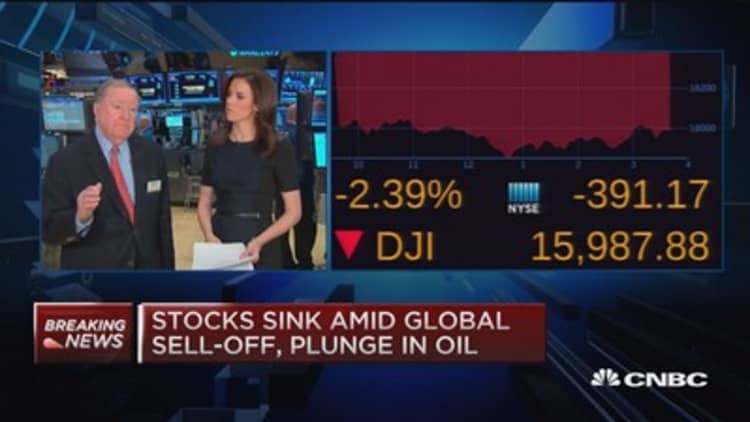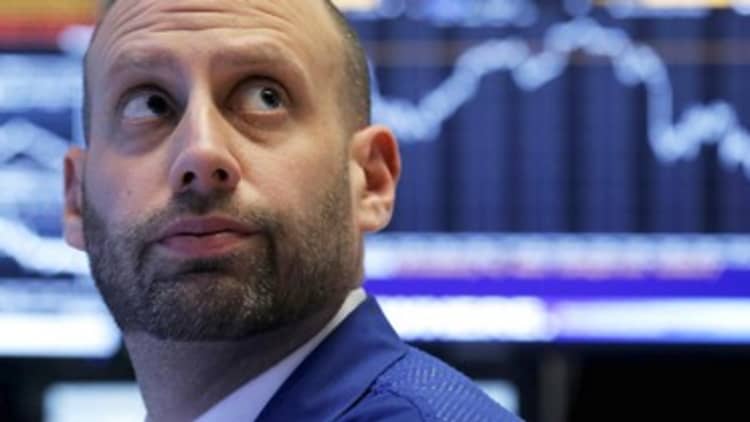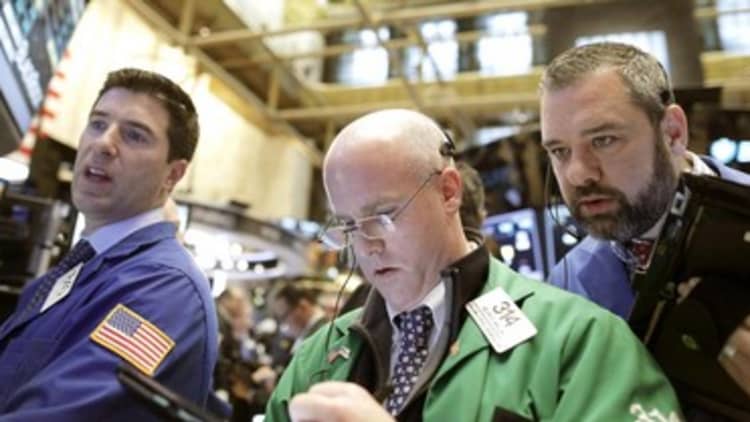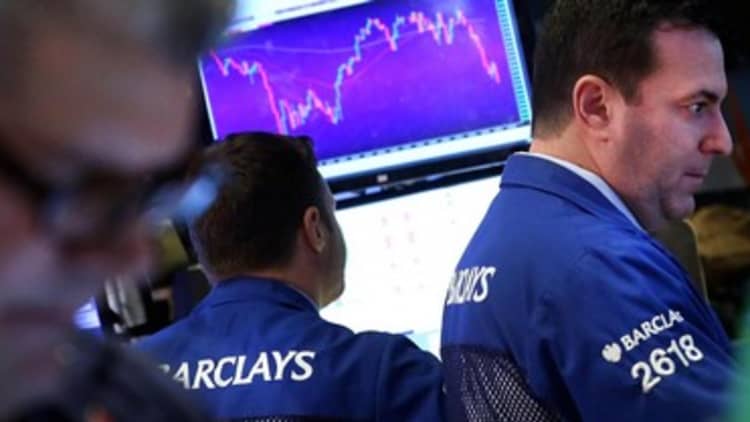






U.S. stocks closed sharply lower Friday ahead of a long weekend and the onslaught of earnings season, after a slew of disappointing U.S. data, a plunge in oil to below $30 a barrel, and a sell-off in Chinese stocks added to mounting concerns about slowing global growth.
Stocks ended more than 2 percent lower, well off session lows, but the S&P 500 and Dow Jones industrial average still posted their worst two-week start to a year on record.
The S&P 500 held above its August low of 1,867 in the close. The index briefly fell 3.5 percent in midday trade to below that level, to its lowest since mid-October 2014. (Tweet This)
Read MoreRecession, bear market fears lead to market rout
"Momentarily, yes, it is encouraging and it will not be a negative anecdote for the day, but you've got some pretty good catalysts in China GDP and the fact that we're closed for the day (Monday). The sense is that this is a longer process," said Ryan Larson, head of equity trading, U.S., RBC Global Asset Management (U.S.).
U.S. stock markets are closed Monday for Martin Luther King, Jr. Day. China GDP is among the few data points from the country due out ahead of Tuesday's U.S. trading session. Friday also marked an options expiration day that likely contributed to some volatility.
"Obviously it started with growth concerns overseas and now we're (hitting) ourselves with the same growth concerns as retail sales were weak and Empire manufacturing that collapsed," said Peter Boockvar, chief market analyst at The Lindsey Group.
The Dow Jones industrial average closed about 390 points lower after earlier falling nearly 537 points. The Dow closed below the psychologically key 16,000 level for the first time since Aug. 25, with Goldman Sachs contributing the most to declines.
"I think some of that was overselling. Still, (about) 400 points is pretty serious. I think going into the close I think things could possibly get better," said Douglas Cote, chief market strategist at Voya Investment Management. He's telling investors, "stick to global diversification and don't panic."
Read More
"This seems overdone, (but) oil under $30 raises a lot of concern about the impact to not only energy but also the banks and their exposure," he said.
U.S. crude oil settled down $1.78, or 5.71 percent, at $29.42 a barrel, the first settle under $30 in 12 years. WTI lost 11.3 percent for the week, its worst in more than a year.
The CBOE Volatility Index (VIX), widely considered the best gauge of fear in the market, briefly topped 30 for the first time since Sept. 1.
"Taking out that August low is definitely concerning," said John Caruso, senior market strategist at RJO Futures. "It may not happen in the near term, (but) definitely low prices are coming."
Financials closed down 3.4 percent to lead all S&P 500 sectors lower. Information technology and energy were the second and third greatest decliners, respectively.
"The fact that financials are leading it after positing good earnings is troubling," said JJ Kinahan, chief strategist at TD Ameritrade.
Read MoreEarly movers: GE, INTC, YHOO, GS, C, BLK, & more
The Dow transports closed down 1.6 percent after earlier falling more than 3 percent. Avis Budget led decliners.
Oil fell sharply to hit fresh lows amid the China stock sell-off and concerns about more oversupply from possible lifting of international sanctions within days that could increase Iranian oil exports. The weekly rig count showed a decline of 1, according to Baker Hughes.
Brent crude settled down 6.28 percent at $28.94 a barrel, its lowest in nearly 12 years. Brent lost 13.7 for the week, its worst weekly decline since 2008.
Dow futures briefly fell 400 points and the 10-year Treasury yield dipped below 2 percent after in December. Ex-autos, retail sales also fell 0.1 percent.
The 10-year yield was near 2.03 percent and the around 0.84 percent around the U.S. stock market close.
"We suffered some real technical damage and the thing that worries me is this systemic lack of confidence. I still think the fundamentals are solid," said Brad McMillan, chief investment officer at Commonwealth Financial. "The U.S. economy is not going into a recession anytime soon."
Read MoreFANG bites back: Amazon, Netflix dictate sell-off
In economic news, the January Empire manufacturing index was minus 19.4.
Industrial production for December fell 0.4 percent. Capacity utilization was 76.5 percent.
The Producer Price Index fell 0.2 percent in December after rising 0.3 percent in November.
November U.S. business inventories fell 0.2 percent.
January U.S. Michigan preliminary was 93.3.
Read MoreInvestor hopes sag to worst in 11 years: Survey
"What (the data) is saying is the U.S. economy in the fourth quarter is slowing and the data is in line with that expectation of that slowdown. However, the market's concerns of recession are much more elevated than they were a few days ago because of emerging markets, China and commodities," said Krishna Memani, chief investment officer at OppenheimerFunds.
"Because investors don't trust underlying data coming out of (emerging market) countries much, they are looking at market indicators as proxies," he said, noting he thinks concerns about emerging markets are overblown.
The iShares MSCI Emerging Markets ETF (EEM) closed nearly 4 percent lower.
Overseas, the about 3.5 percent after Chinese loan data renewed concerns about the pace of economic slowdown. The People's Bank of China set the yuan mid-point fix at 6.5637, comparatively flat relative to Thursday's fix of 6.5616. The Shanghai composite is down more than 40 percent from its 52-week intraday high.
closed down more than 2.5 percent. The STOXX Europe 600 and German DAX are both down more than 20 percent from its 52-week intraday high, in bear market territory.
Read More
The U.S. dollar index was down about 0.2 percent. The euro was at 1.09 and the yen at at 116.94 yen against the greenback.
"Simply put, we're not talking about a wall of worry right now. We're talking about a mountain," Larson said.
"It's not anything new. It's the continued persistence of global growth concerns," he said.
White House spokesman Josh Earnest said Friday the market action is "closely watched at the Treasury Department" and that financial markets around the world are under watch. The White House does not usually comment on market moves.
New York Federal Reserve President William Dudley said that future rate hikes depend on data and that rates are set to continue on gradual upward path. He added that overseas economies pose risk to the United States and there's little change in outlook since the Fed meeting.
Core inflation is quite stable despite lower energy, Dudley said, noting 2016 growth is to be slightly above 2 percent.
Read MoreFed fund futures push first expected rate hike to July: CME data
San Francisco Federal Reserve Bank President John Williams told Reuters Friday the stock market's swoon does not change the economic outlook and is merely market participants trying to make sense of global developments,
"If the Fed is not going to be underpinning the market, the valuations have to fall into line with fundamentals," said Quincy Krosby, market strategist at Prudential Financial.
"This (sell-off) should not be a surprise to the market. This has been telegraphed to the market for some time. ... This is not abnormal for four years of no pullbacks," she said.
The Dow Jones industrial average closed down 390.97 points, or 2.39 percent, at 15,988.08, with Intel leading all constituents lower.
The Dow lost 2.19 percent for the week. DuPont was the greatest decliner on the week, while Exxon Mobil was the best performer. The index is down 8.25 percent for the year so far.
The closed down 41.55 points, or 2.16 percent, at 1,880.29, with financials leading all 10 sectors lower.
The index fell 2.17 percent for the week, with materials the worst performer and utilities the only gainer. The S&P is down 8 percent for the year so far.
The Nasdaq composite closed down 126.59 points, or 2.74 percent, to 4,488.42.
The Nasdaq lost 3.34 percent for the week, with Apple up 0.18 percent for the week but the iShares Nasdaq Biotechnology ETF (IBB) down nearly 6 percent. The index is down 10.36 percent year-to-date.
All three major U.S. averages are more than 10 percent below their 52-week intraday highs, in correction territory.
About five stocks declined for every advancer on the New York Stock Exchange, with an exchange volume of nearly 1.5 billion and a composite volume of almost 5.5 billion in the close.
High-frequency trading accounted for 49 percent of January's daily trading volume of about 8.97 billion shares, according to TABB Group. During the peak levels of high-frequency trading in 2009, about 61 percent of 9.8 billion of average daily shares traded were executed by high-frequency traders.
Gold futures for February delivery settled up $17.10 at $1,090.70 an ounce.






